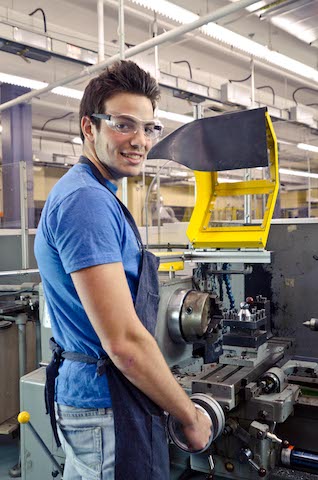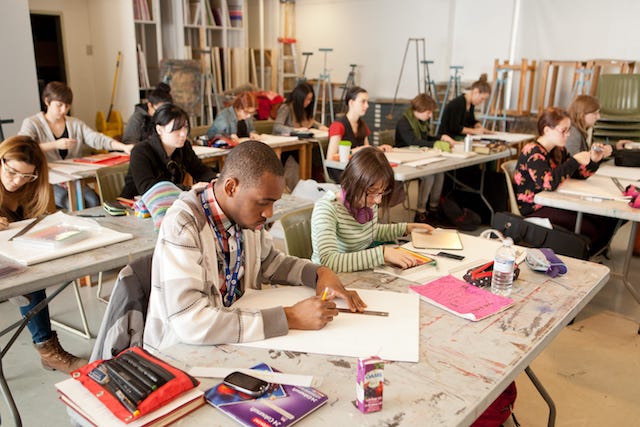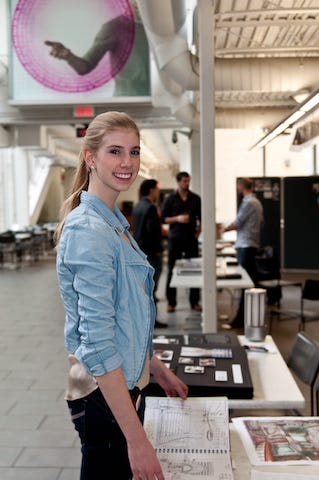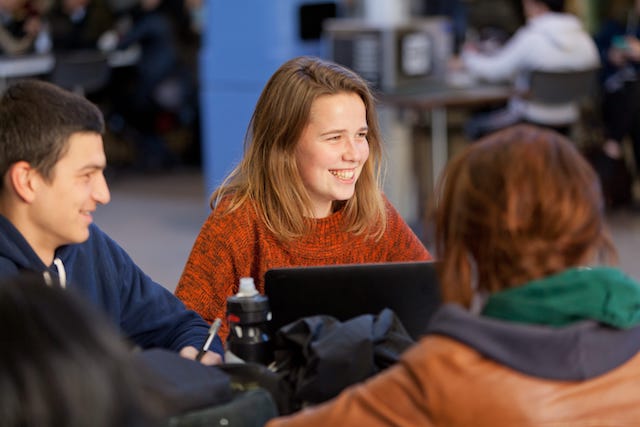Josée Garceau visited Dawson on October 18, 2019. Her talk, “Phigitals (Generation Z): a new generation of students emerging from a society in transition,” launched the Faculty Hub’s Student-Centred Teaching Series. Author of the book, La cohabitation des générations, Josée Garceau occupied different positions during her 25-year career at the Université de Sherbrooke, most notably as the Director of student recruitment. Her contact with students and youth, complemented by her research on Generation Y and inter-generational relations, has allowed her to develop an expertise in this field. For the past decade, she has been sharing her insights on inter-generational relations in education and in the workplace with organizations across the province.
The following article summarizes the highlights of her presentation.
Defining a new generation: Who are the Phigitals?
No clear dividing line separates one generation from another. Depending on whether the researcher is a historian, a sociologist or a demographer, the precise dates used to define a particular generational group might vary, but the overall characteristics of that group will largely be the same. Someone born at the end of one generation or at the beginning of another will share many of the characteristics of both groups. As a result, students coming into college classrooms today are like Millennials, but with a twist. I call them Phigitals, which is a fusion of the physical and digital worlds. For Phigitals, both worlds are integrated. The term Phigital conveys more meaning than “Generation Z” because it communicates a very important characteristic of this new generation.
 Many different factors – family, early education, culture, economic opportunity, technological change, etc. –have an influence on the characteristics and values of a generation.
Many different factors – family, early education, culture, economic opportunity, technological change, etc. –have an influence on the characteristics and values of a generation.
- Did both parents work and were there one or more siblings? The nature of a family will affect how individuals see their place in it and how they see their place in society.
- Did the student go to a private school or a large public school?
- What cultural message was communicated to the young as they were growing up? Work hard, make money and have a big career. Love what you do. You can do anything…
- What were the job opportunities? Difficult situations at the start of working life will affect people’s relationship with money and their need for security, and will continue to influence them many years later even after they have found a good job.
- How does technology allow people to see and think about the world? Today’s technology allows people to know about, and be influenced by, what is going on in their neighbourhood or halfway around the world.
When we ask why members of the younger generation think and act the way they do, it is important to remember that characteristics are acquired, they are not innate. The younger generation has been shaped by all the influences of the society around them, a society that we adults have created. The new generation has moved from the concept of succeeding in life to having a successful life. When a person thinks about having a successful life, she or he will not make the same decisions or establish the same priorities as someone who wishes to succeed in life.
Some differences and similarities between Millennials and Phigitals
| Generation Y (Millennials), born 1982-2000 | Generation Phigital, born 2001- |
| Hedonist | Curious, resourceful, egalitarian |
| Team-oriented | Personal projects |
| Full and balanced life | Committed to searching for solutions |
| Fun, family and friends | Social engagement, discovery, experimentation |
| Live in the present, pragmatic, time-obsessed | Financially prudent but willing to take risks, pragmatic |
| Need to find meaning in everything they do, always ask “why”, no regrets | Need for personalization |
| Random vision, opportunistic | ? [too early to tell] |
Many Phigitals have a personal project and they see their education as a way to create building blocks that will help them realize their project. As much as Millennials want a formula to do something, without having to re-invent the wheel, Phigitals search for new solutions and are much more open to experimentation. They want to be able to apply what they are learning right away.
As students, Phigitals want discovery instead of memorization; they retain information by applying it to a task. The teacher is more a leader and coach, rather than someone who possesses all the knowledge and expertise; the teacher is someone who can help them achieve their goals.
When Millennials are asked to do something, they will ask “why?” As adults or teachers, we might see this response as a reflection of laziness, a lack of commitment or a challenge to our authority. But Milliennials want to know why they should invest their time in doing something. Once they have that context, one that is truthful and logical, they are more likely to be motivated.
 Phigitals need personalization in everything, and that is increasingly how they see their courses. They will go to the classes that interest them and help them develop a competency they want. They know, however, that to do some things, such as become a doctor or engineer, they have to follow a whole program of study. But more and more students want to carve their own path and invent their own job, so when they go to college or university they seek greater freedom to choose, or tweak, assignments. They are not trying to negotiate something easier but they want something that is adapted to their own needs, projects and values.
Phigitals need personalization in everything, and that is increasingly how they see their courses. They will go to the classes that interest them and help them develop a competency they want. They know, however, that to do some things, such as become a doctor or engineer, they have to follow a whole program of study. But more and more students want to carve their own path and invent their own job, so when they go to college or university they seek greater freedom to choose, or tweak, assignments. They are not trying to negotiate something easier but they want something that is adapted to their own needs, projects and values.
Members of this new generation are increasingly inclined to take a less direct path through their education. Since students do not have a defined path, any conversation about their goals is likely to look forward only as far as a year or two. It is not unusual for these students to take a break after high school or during the middle of their studies, even though the educational system is not made for this. Students who do take a break in the middle of their studies will try to re-integrate directly into their program, claiming that the experience they gained in their outside activity should be recognized academically. If they are not successful, they might simply abandon their studies, knowing that they can easily get a job in an economy where there is a shortage of workers and that some very prominent dropouts have succeeded without a diploma.
Members of this generation will not wait for the perfect job. They see their power in being able to find what they need or doing something themselves. They do not consume as much: they share a lot with their friends and family, they live in apartments and they do not own cars – in fact, the majority do not have a driver’s licence. By avoiding large financial commitments, they have more disposable income and are freer to do what they want. They want to do many things, not necessarily specialize in one thing or stay in a job for many years.
The impact of technology on the new generation
Technology changes attitudes and behaviours, with important consequences for the construction of identity and the development of autonomy. Members of the new generation learned how to relate to others through social media, creating unrealistic expectations of themselves and the world. When they were young and temporarily left on their own, they were still connected and so felt safe. But this sense of safety was a false one because it was not based on aptitude but on the ability to reach parents or friends in a few seconds. With too much information at their fingertips and too little time to verify it and reflect upon it, they will sometimes make rash judgements and decisions.
| Characteristic | Outcome |
| Know how to find information on the Web | The classroom can be anywhere, and at anytime. Students do not show up in class. |
| Magical thinking | With Google, solutions are a fingertip away. |
| Accustomed to having control | When something is uninteresting or boring, they can move on with a click. Waiting is unbearable. |
| Content producers | Not used to being passive: students are less inclined to participate in a class that does not allow for their style of communicating. |
| Use technology differently than other generations | The phone is used for everything except making phone calls and picking up voice messages. Limiting the use of cell phones in class seems artificial because they are used all the time in the workplace. |
| Protected by a “virtual shield” | Difficulty with face-to-face interpersonal relationships: students do not want to talk about their problems and they have difficulty in listening to bad news or in receiving even gentle criticism. |
| Constantly connected | Work and personal lives are intertwined 24/7. Students do not understand that teachers are not connected all the time. Teachers need to set limits. |
| Normal and expected interruptions | Students are accustomed to interruptions (on average they receive about 125 interruptions per day), and without these micro breaks they become stressed and tired. |
| 80% have a social media profile | Non-stop pressure because students are constantly connected and because social media sets certain expectations about having friends and fun. The constant pressure and the need for constant validation create anxiety. |
| FOMO (fear of missing out) | Individuals have a desire and sense of responsibility to help their friends and, when a crisis occurs and they are out of contact for an hour or two, they feel that they are not being a good friend. |
Adjusting teaching for the new generation
 Why are students not coming to class?
Why are students not coming to class?
- They are very busy and want the essentials;
- They choose to invest their time where the return is most interesting (results, pleasure);
- Passive teaching;
- Having excellent grades changes little (except for access to higher education);
- Being in school is an element of their life, but not all their life;
- There is not enough connection with personal projects, values, etc.;
- They will exercise their trade differently; information and networks are accessible at all times: “I don’t need to learn it if I know where to find it.”
As teachers, your competition is not another program or college, it is YouTube and the Internet. Students can find many videos made by competent and skilled communicators, and can learn at home when they want, how they want and as much as they want. However, by asking the right questions, and by using openness and creativity, it is possible to teach students in a way that will interest and engage them while creating an environment that promotes the pleasure of both students and teachers.
A few tips for teachers
Variety: Use different teaching methods (lectures, teamwork, guest speakers, case studies, concrete projects, etc.) as well as different platforms (YouTube, websites, sharing sites, forums, micro-teaching on the Web, etc.). Also, consider teaching in a variety of places. Depending on the topic, it could be outdoors, in a space that is relevant to what is being taught or in a place that promotes creativity or enables students to see the topic in a different light.
Concrete and present: Demonstrate that new knowledge is relevant now, not just when students eventually enter the labour market. Use examples to show how the new competencies will help students to realize their own projects.
Prepare for continuing education: Society is changing at a frenetic pace; it will require a capacity for continuous adaptation. Nothing – not even competencies – will be spared. Young people must learn to learn, make the right choices regarding their sources of learning and have both a critical mind and method.
Information at the right time and in the right way: Access to information (which is easy enough) is less important than its immediacy and the choice of medium. Delivering information in real time through a medium that is not unidirectional and that allows for interaction is key (YouTube, Instagram, Snapchat, etc.). Facebook is the tool of Generation Y. To use the right communication channel, do not hesitate to ask students what they prefer at the beginning of the semester.
Provide the opportunity to produce learning content: The Phigital generation is certainly at ease creating content; it instinctively shares knowledge and wants to be in the thick of the action. Asking students to create a video, a website or tools to learn a concept, a technique or to develop a competency creates teamwork skills and gives teachers the opportunity to understand students’ vision, priorities and interests.
Use technologies in an integrated way. Too often, technologies are added after the course has been created and seem to be an afterthought. Instead, they should be part of a deep reflection on the best ways to interest and transmit material to students, students for whom the use of technologies is the only way of life they know.
Integrate soft skills in teaching. With society and technology in rapid transition, the development of soft skills needs to take up more space in education because employers want employees who can adapt to jobs that are constantly changing. Since information will be available all the time, what will differentiate one employee from another will be their soft skills: cognitive skills (critical thinking, synthesis, complex problem solving, creativity); social skills (emotional intelligence, listening, empathy, influence, negotiation, ability to work as a team); and technology skills (data analysis and programming). Foremost among these skills will be the ability to evaluate, organize, analyze and apply the vast amounts of information that can be taken from the Web.
See also Katherine McWhaw’s article “The changing student profile” in this issue.




